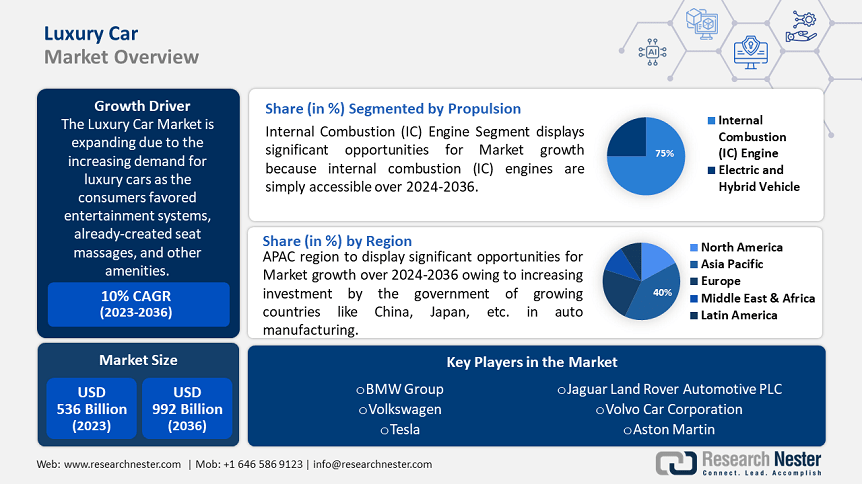
Luxury Car Market size is expected to reach USD 992 Billion by the end of 2036, growing at a CAGR of 10% during the forecast period, i.e., 2024-2036. In the year 2023, the industry size of luxury cars crossed USD 536 Billion. The increasing demand for luxury cars as the consumers favored entertainment systems, already created seat massages and other amenities will exponentially help the market to grow in the expected CAGR. Luxury automobiles are a desirable investment for auto aficionados since they frequently hold their value better than mass-market automobiles. Classic luxury vehicles and limited-edition models have the potential to increase in value over time, providing a return on investment. For instance, the Ferrari 250 GTO is valued at tens of millions of dollars, making it one of the most valuable vehicles in the world.
Another reason to propel the luxury car market by the end of 2036 is the current global economic blast. Moreover, according to market research following a 3.1 percent growth rate in the previous year, the global economy is expected to contract significantly in 2023 to 2.1 percent due to further tightening of monetary policy to contain excessive inflation. There will then be a mild recovery to 2.4 percent in 2024. It is anticipated that the resilience shown by global economic activity early this year will diminish. With China's economy recovering more quickly than anticipated and the United States' consumption remaining robust, growth in many major economies was greater than anticipated at the start of the year.

Growth Drivers
Challenges
|
Base Year |
2023 |
|
Forecast Year |
2024-2036 |
|
CAGR |
∼10% |
|
Base Year Market Size (2023) |
~USD 536 Billion |
|
Forecast Year Market Size (2036) |
~USD 992 Billion |
|
Regional Scope |
|
Vehicle Type (Hatchback, Sedan, Sports Utility Vehicle, Multi-Purpose Vehicle)
The sports utility vehicle segment is expected to hold 57% share of the global luxury car market during the forecast period because of the intensive demand for sports utility vehicles across the world. For instance, in America, Sedan sales now account for just 22.1% of the market, with a new sector capturing 47.4% of all automobile sales, despite decades of popularity for cars like the Honda Civic and Toyota Camry. For many years, SUVs have been more and more popular than sedans. In 2023, they surpassed sedans in market share, and it is expected that this trend will continue in the years to come. SUVs consume more gas and release more CO2 into the atmosphere than sedans because they are heavier and less fuel-efficient.
Fuel Type (Gasoline, Petrol or Diesel, Electric)
The petrol or diesel segment in the luxury car market is projected to account for 45% of the revenue share by 2036, owing to the increasing customer inclination towards petrol despite the prevalence of electric substitutes globally. For instance, in Austria, cars powered by gasoline or diesel are the preferred choice for all age categories (50% of car purchasers under 30, 50% of persons over 65, and 48% of individuals between the ages of 30-64 would buy one).
Propulsion (Internal Combustion (IC) Engine, Electric & Hybrid Vehicle)
The internal combustion (IC) engine segment will have superior growth during the forecast period and will hold around 75% of the revenue share of the luxury car market because internal combustion (IC) engines are simply accessible. About 25% of the world's power comes from internal combustion (IC) engines running on fossil fuel oil (about 3,000 out of 13,000 million tons of oil equivalent annually), and in the process, they generate 10% of global greenhouse gas (GHG) emissions.
Our in-depth analysis of the global market includes the following segments:
|
Vehicle Type |
|
|
Fuel Type |
|
|
Propulsion |
|
|
Vehicle Class |
|
|
Price Category |
|
APAC Market Statistics
The luxury cars market in the APAC region will have the biggest growth during the forecast period with a revenue share of around 40%. This growth will be noticed owing to increasing investment by the government of growing countries like China, Japan, etc. in auto manufacturing. For instance, according to luxury cars market research, China launched "Made in China 2025," a long-term industrial strategy, in 2015 to make the country a global leader in vehicle manufacture by the year 2025. A target of 20% of all new automobile sales will be electric and other new-energy cars by 2022, according to the policy.
European Market Analysis
The luxury car market in the Europe region will also encounter huge growth during the forecast period and will hold the second position owing to the increasing awareness of European people for sustainability. Living well within planetary limitations is the EU's long-term objective for 2050, which is reaffirmed in the 8th Environment Action Programme (8EAP). It lays forth the key goals for 2030 together with the prerequisites for achieving them. The EU might not satisfy the majority of the monitoring objectives listed in the European Commission's eighth EAP Monitoring Communication, according to the European Environment Agency's (EEA) first monitoring report on the Program.



Author Credits: Harshita Srivastava, Saima Khursheed
FREE Sample Copy includes market overview, growth trends, statistical charts & tables, forecast estimates, and much more.
Have questions before ordering this report?